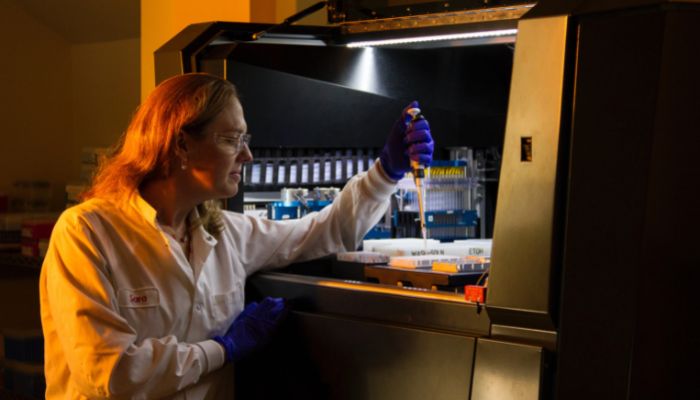|
Proteins are related to hypoxia, blood vessel disease, and collagen turnover by Patricia Inácio, PhD The levels of three blood proteins — endostatin, basic fibroblast growth factor (bFGF), and platelet-activating factor acetylhydrolase (PAF-AH) beta subunit — may help predict the risk of progression from early to definite systemic sclerosis (SSc), according to a new study. “In particular, endostatin was the protein most strongly associated with disease progression, and it is worthwhile to further investigate its mechanistic roles for its possible pathogenetic [disease] role in SSc development and its therapeutic potential,” the researchers wrote in the study, “Proteomic aptamer analysis reveals serum markers that characterize preclinical systemic sclerosis (SSc) patients at risk for progression toward definite SSc,” which was published in Arthritis Research & Therapy. In SSc, or scleroderma, the immune system wrongly recognizes the body’s own proteins as foreign and mounts an immune attack by producing antibodies against them. The hallmark of SSc is thick and hardened skin, but other organs can be damaged. At early (preclinical) stages, symptoms are typically limited to Raynaud’s phenomenon, a condition wherein the fingers and toes become numb and cold in response to low temperatures or stress, along with SSc-specific autoantibodies, and abnormalities in the small blood vessels of the nail folds. About 50% of patients with preclinical SSc progress into definite SSc within five years of being diagnosed. Understanding what promotes that progression may help uncover potential therapeutic targets. Blood proteins and predicting disease progression
Researchers from Italy and the U.S. analyzed the protein content of blood samples from preclinical SSc patients and compared it to samples from healthy people of the same age, gender, and ethnicity. The first group of preclinical SSc patients — called the discovery group — was composed of 13 patients (mean age, 53.5; 76.9% women). All were positive for SSc-related autoantibodies, namely antinuclear antibodies (ANAs), including anticentromere antibodies (ACAs, 61.5%) and anti-topoisomerase I antibodies (23.1%). After four years, seven (54%) progressed into definite SSc with limited cutaneous scleroderma features (six patients had puffy fingers). Study start comparisons showed no differences between those whose disease progressed to those with no such findings regarding the percentage of ACAs and measures of lung function, namely forced vital capacity (FVC) and diffusing capacity for carbon monoxide (DLCO), a test of the lungs’ capacity to transfer oxygen from the air sacs into the blood. FVC measures the amount of air that can be forcibly exhaled from the lungs after a deep breath. The team used a platform, called SomaScan, to assess protein levels. Among 1,306 detected proteins, 286 were significantly different between patients and controls. Ten proteins were deemed significantly associated with developing definite SSc. These proteins were involved in blood vessel formation (angiogenesis) and a process of cell migration called chemotaxis. The researchers then validated the diagnostic potential of these 10 proteins in a second (validation) group of 50 preclinical SSc patients (mean age, 55.9; 88% women). Twenty (40%) progressed into definite SSc within five years. The typical signs of disease progression were skin involvement, namely puffy fingers in 13 cases (65%) and skin scarring in seven patients (35%) with limited cutaneous SSc. Telangiectasias, a dilating of small blood vessels right below the surface of the skin, co-occurred with these in six cases (30%). A shorter time of progression to definite SSc was linked to having Raynaud’s for fewer than 10 years at the study’s start and to having acid reflux. The levels of endostatin, bFGF, and PAF-AH beta were significantly associated with SSc progression, further assays showed. These proteins are involved in regulating angiogenesis and blood vessel disease. In particular, endostatin, a protein released in low oxygen conditions (hypoxia) and in response to low blood flow (ischemia) was linked with a 10.23 higher risk to progressing into definite SSc. Risk for progression was set at a cutoff of at least 124 picograms per milliliter (pg/mL) for endostatin, under 4.9 pg/mL for bFGF, and under 2.1 ng/mL for PAF-AH beta. Preclinical SSc “showed a distinct protein profile and proteins that are related to hypoxia, vasculopathy [blood vessel disease], and collagen [a main protein of scar tissue] turnover, which emerged at characterizing the progression from a preclinical stage of SSc to a definite one,” the researchers wrote. Comments are closed.
|
AuthorScleroderma Queensland Support Group Archives
July 2024
Categories
All
|
Scleroderma Association of Queensland
©Scleroderma Association of Queensland. All rights reserved. Website by Grey and Grey.

